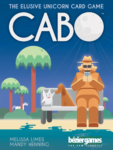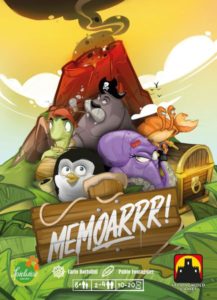- Learning time
- 5 minutes
- First play time
- 60 minutes
CABO
Designed by: Mandy Henning,Melissa Limes
CABO is a game of luck-pushing, memory, and a little bluff.
The game consists entirely of a deck of cards, four of each number from zero to thirteen. Each player is dealt four cards face-down, and you may only look – secretly – at two of your own cards, with the other two a mystery – for now. Your goal is to be the player with the lowest collective value of cards.
On a turn, players have three options. What you’ll probably doing most of is taking the top card from the deck and deciding whether to swap it with one of your own cards (if it’s a nice low card) or discarding it (if it’s a high card). But the high cards have special powers you can use when you discard them: peeking at one of your own cards, spying on someone else’s, or swapping one of your own cards with someone else’s.
Secondly you can take the top card from the discards instead, swapping it with one of your own but this time, face-up.
Additionally, you can elect to swap for multiple cards and thus, get your four cards down to three or less. The catch here is that the multiples you discard must be the same number: it’s very easy to get this wrong when so many cards are being moved, swapped, along with the challenge of remembering where your cards are, even if you know their numbers. If you attempt to shed more than one card and they don’t match, you have to keep them along with the card you picked up!
Finally, if you feel confident you have four low cards, you can forego picking up cards at all to call ‘Cabo’ and trigger the end of the round. Everyone else gets one last turn (enough time to swap cards with you, possibly) and then everyone’s hands are revealed: everyone scores the number value of their card (-points are bad) but a successful ‘Cabo’ call scores zero, whereas an unsuccessful ‘Cabo’ adds on another ten to your number score instead. Oof!
The game continues until one or more players sail over 100 points at which point the player with the fewest points wins. But there are a couple of catches worth mentioning here: first, a hand of two 12s and two 13s at the end of the round scores you zero and everyone else 50 points. A great move, but exceedingly tricky to pull off. Second, if instead of going past 100 points, you manage to score 100 exactly, your score reverts to 50 instead: a funny way to catapult yourself from potentially-last into potentially-first!
Note: there is an older version of Cabo still available with slight rules changes that plays up to 5 players instead of 4
The guru's verdict
-
Take That!
Take That!
It can be a fairly combative feeling game, with cards being snaffled from each other on a semi-regular basis.
-
Fidget Factor!
Fidget Factor!
But it's also very fast-moving.
-
Brain Burn!
Brain Burn!
Low on rules. Any cognitive conflagration is really about the memorising. After looking at your cards at the start of the game, there is no 'checking' allowed!
-
Again Again!
Again Again!
The game lives or dies on how the players feel about the memory challenge. Playing randomly will give a pretty empty experience, so it's for players who like that aspect will enjoy repeat visits.












Sam says
This is a fun game with more going on that first meets the eye. It's predominantly a memory game, certainly, so if that doesn't appeal at all it's possibly best avoided. Ideally you need to not only track what your own cards are, but what your opponents are not getting rid of. But it's also a game of decisions, with each card flip giving you a choice, and a game of risk: some of the funniest moments are when someone sheds a card they haven't actually seen, only to find they've gifted the next player a 1 or a zero. Now that player needs to beware someone stealing it! With the full complement of players sometimes it can run a little long, but you can always house-rule an 80-point end-game trigger or something like that.